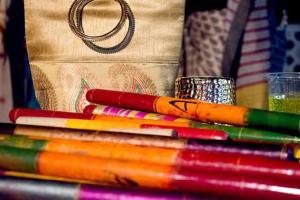Navratri is not just about garba and dandiya nights with fun and devotion towards Goddess Durga

This image has been used for representational purposes only
Navratri is that time of the year when revelers look forward to wearing colourful costumes and dance the night way with friends and family. And Mumbaikars have already started preparing for the festival by flocking into their nearby dance studio to master their garba moves and shopping for the best of colourful outfits. But Navratri is not just about wearing fancy clothes and playing garba. The nine days running up to Dussehra symbolizes prosperity, well-being and triumph of good over evil.
This year, Sharad Navratri begins from September 29 to October 7. These nine days are said to be of immense importance for Hindus all over the world. It is on these days that revelers fast and pray to the nine incarnations of Goddess Durga. The deity is known to symbolises positive energy that is powerful enough to destroy the evil forces and protect devotees from them. Each day of the festival has different, interesting significances.
ADVERTISEMENT
Daily devotion
On the first day of the festival, the devotee worship Shailaputri, worshipped as the consort of Lord Shiva. The second day of the festival is dedicated to Brahmacharini, who is known to be blissful and bestow happiness, prosperity and peace among her devotees. On the third day, Goddess Durga is worshipped as Chandraghanta, known for beauty and grace. The fourth day is dedicated to Kusmanda, who symbolises happiness and is known to have created the universe through laughter.
On the fifth day, Goddess Durga is worshipped as Skandamata, representing the protective maternal instincts. Devotees worship Katyayani on the sixth day of the festival that stands for courage. The seventh day is dedicated to Kalratri, the most fierce form of Goddess Durga that represents peace. On the eighth day, Gauri is worshipped as she stands for calmness and prosperity. And the ninth day is dedicated to Siddhadatri, known for her supernatural healing powers. Revellers observe fast and follow different colours on each day of the festival that adds to its fervour. The colours used are in accordance with the significance of the days of Navratri.
Regional traditions
Each region has different traditions as far as the days of Navratri are concerned. In the eastern India, especially West Bengal, the festival is celebrated as Durga Puja or Pujo. Pandals are put up in different parts of the region and the idol of the deity is worshipped. The idol is immersed in a huge ceremony on Dussehra, symbolising the victory of good over evil. In Delhi, Ramlila, a play based on the events described in Ramayana is staged in front of scores of spectators. In the south, the eighth, ninth and the tenth is dedicated to Goddess Saraswati. On the tenth day, known as Vijayadashami, devotees from all walks of life worship their equipments in a puja known as Ayudha puja. Students worshipped their books, pens and pencils in their houses or temples. In some parts of Southern India, children initiate the beginning of their education on this auspicious day.
Garba Raas
The most prominent part of Navratri is the Raas Garba. A dance form that said to be was originated in Vrindavan, but is of prominence among the Gujarati community, the garba is danced encircling a lamp called as Garbadeep, that symbolises a foetus in her mother’s womb. The moves of the dance form in which the dancers move their hands and feet on circular motion are known to symbolise the circle of life. Apart from Sankalp Dandiya programmes that held across Mumbai where popular garba singers is seen performing, even cultural clubs and housing societies organise raas garba where people wear the traditional attire as per the colour of the day, socialise with others and dance their heart out. The songs on which the garba is danced praises the divinity of Goddess Durga. Dandiya raas, another variant of the form is danced with colourful sticks.
mid-day wishes its readers and followers a happy and blessed Navatri.
Catch up on all the latest Crime, National, International and Hatke news here. Also, download the new mid-day Android and iOS apps to get the latest updates
 Subscribe today by clicking the link and stay updated with the latest news!" Click here!
Subscribe today by clicking the link and stay updated with the latest news!" Click here!







